Most of the historians and archaeologists are of the opinion that Mesopotamia was the birthplace of civilization. The presence of a water-full river made it the cradle of the most important civilizations with very convenient communication position that brought about contact with other lands. Most sciences, and most importantly, probably the origin of writing is from ancient Mesopotamia. The first important cities of world’s history were also established in this land that created the rules of civil life.
Definition of Ancient Mesopotamia
The perceptible superiority of the ancient Mesopotamia civilization made that land the focus of attention of its neighboring tribes, and hence the movement of tribes and conflicts between them, although on the one hand it caused its history to be turbulent, on the other hand it also caused the diversity and development of culture. Been . Following this tumultuous history, while more than 3000 years of ancient Mesopotamian civilization had passed, around 500 AD. Its political life ended and it became part of the history.
With an area of about 200,000 square kilometers, the land of Mesopotamia refers to the lands located between the rivers Tigris and Euphrates, including their side lands. Situated in the fertile valleys between the Tigris and Euphrates rivers, the region is now home to modern-day Iraq, Kuwait, Turkey and Syria.
The word Mesopotamia means “the land between two rivers”. It is limited to the the Zagros mountains from the east, the Persian Gulf and the Arabian desert from the south, and the Syria desert from the west. The two rivers Tigris and Euphrates create the Mesopotamia and originate from the Taurus Mountains in Armenia. Of course, along the way, other rivers, including the Zagros-originated rivers, are added to the Tigris and Euphrates rivers.
History of Mesopotamia
Mesopotamia in Western Asia is the place where the first ancient civilizations emerged, and the knowledge of its history and culture, plays an important role in examining the evolution of world’s civilizations.
When the ancient civilizations of Mesopotamia are mentioned, they mean the civilizations that existed from the second half of the 4th millennium BC (approximately 3200 BC) to the first half of the 1st millennium BC (until around 539 BC) – before the entire Mesopotamia came under the rule of Cyrus the Great.
For the first time, the Greeks called it Mesopotamia when Alexander the Great entered this region. The first person who gave this name to this region was Polybius (200 – c. 118 BC), a Greek historian of the middle Hellenistic period whose famous work is called The Histories .
Mesopotamian civilizations include Sumerian, Akkadian, Babylonian, Assyrian, and Chaldean (New Babylonian), which respectively arose and formed governments in this region. The Mesopotamians continued in this region for about three thousand years. These civilizations are equal to the Egyptian civilization in terms of historical antiquity. Some researchers believe that the southern part of Mesopotamia, i.e. Sumer, is the birthplace of the first human civilization.
Also Read : History of Iran
Inventions that Changed the World
Archaeological excavations in Mesopotamia have unearthed a treasure trove of artifacts that provide insight into the culture, lifestyle, and technological advancements of the civilization. From cuneiform tablets to ancient wheels, these discoveries continue to enrich our understanding of Ancient Mesopotamia. Mesopotamian civilizations invented new technologies and perfected the large-scale use of existing ones. In the process, they transformed how humans cultivated food, built dwellings, communicated and kept track of information and time.
WRITING
The Sumerians, like the Egyptians and the Chinese, are among the first peoples who wanted to record their speech and thoughts. To write cuneiform lines, soft clay tablets were needed, which were written on with a wooden pen, and then the tablet was baked or sun-dried. The Sumerian cuneiform script was similar to the Egyptian script at the very beginning of its creation; originally the cuneiform script was a type of pictorial script, but the images gradually took on a simpler and angular form, and finally the symbols forming this script became now called cuneiform.
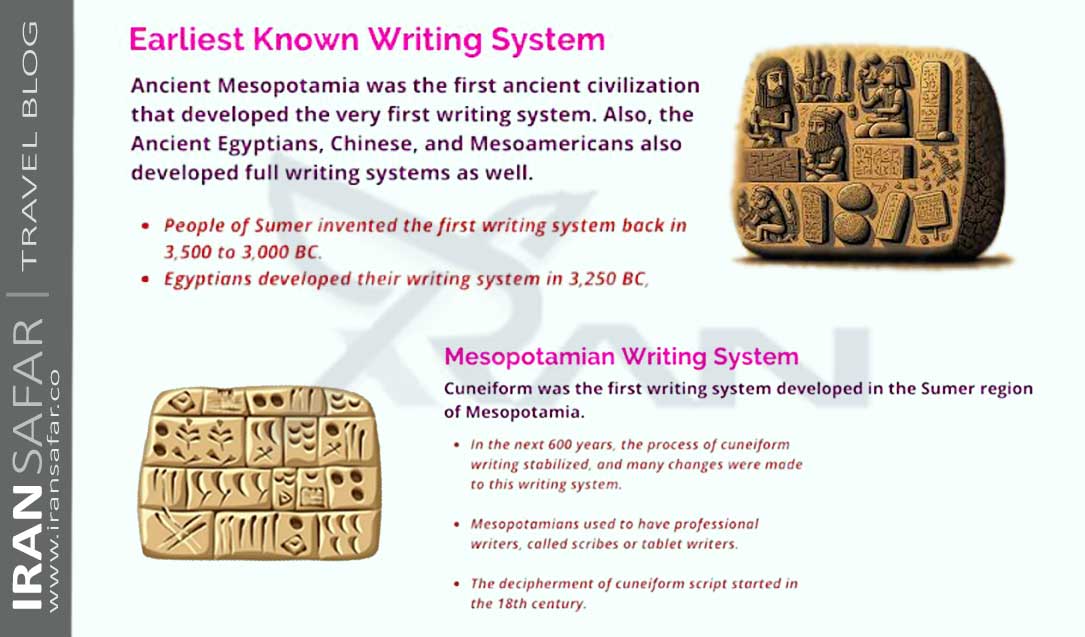
The Sumerian writing system had a pattern top to bottom pattern that later changed from left to right. By 2800 BC, the use of phonetics too had begun. Well, that was just the beginning as there were many other incredible Sumerian inventions that came to life one after another. Different versions of cuneiform scripts were used for more than three millenniums until the Roman era introduced alphabetical forms.
WHEEL
Perhaps, people of the ancient Mesopotamia were not the first civilization to use wheels, but did likely develop the first wheeled chariots (around 3,500 BC) by drilling a hole through the frame of the cart to create an axle, which then connected the wheels to form a chariot.
NUMERAL COUNTING SYSTEM
Ancient people counted using simple methods, such as carving notches into pieces of wood or bones. However, the Sumerians developed a formal number system based upon units of 60 known as the sexagesimal system, which evolved out of a need to create a trade and taxation policy.
Also Read : Jiroft Civilization: one of the oldest in the world
IRRIGATION SYSTEMS
The fertile lands of Mesopotamia were ideal for agriculture, and the Mesopotamians devised advanced irrigation techniques to harness the rivers’ water for farming. Their innovations in agriculture ensured a stable food supply and supported the growth of urban centers.
SUMERIAN CALENDAR
The Sumerians in ancient Mesopotamia made the very first calendar; a complex system that marked time’s passage and regulated religious observances. They developed the concept of a lunar month and a lunisolar calendar, indicating a deep understanding of astronomical cycles and their relationship with seasonal changes. This system divided a year into 12 lunar months, each consisting of 29 or 30 days. However, the Sumerian calendar was very different from the one we use today, a Sumerian year had 360 days.
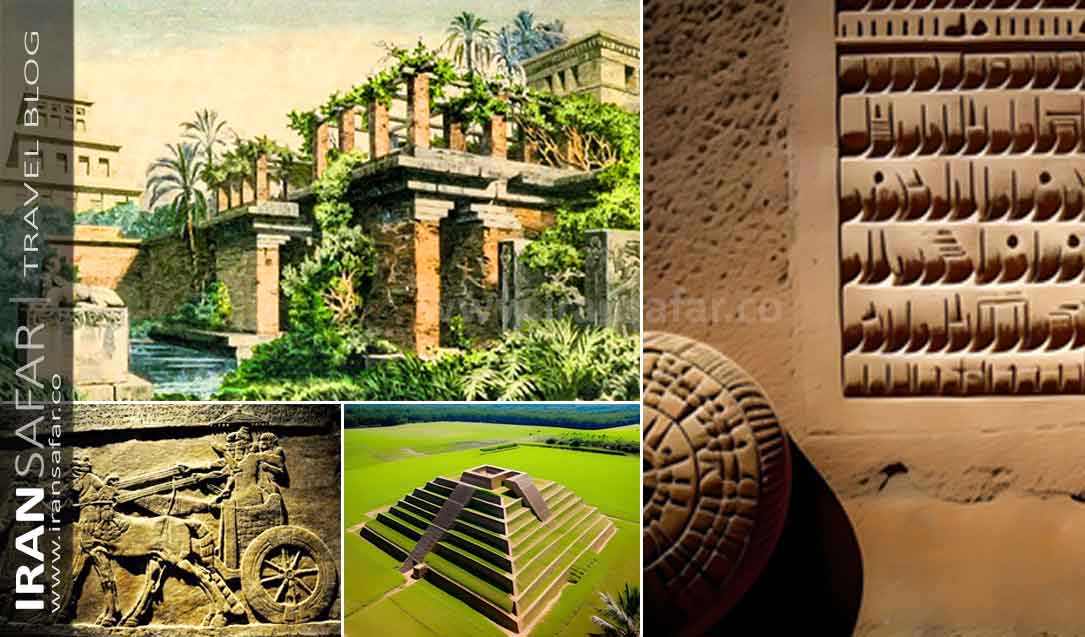
Ancient Mesopotamia Civilizations
When talking about ancient Mesopotamia civilizations, we mean the civilizations that formed from the second half of the 4th millennium BC (approximately 3200 BC) to the first half of the 1st millennium BC (until around 539 BC). Its cradle was the fertile land between the two great rivers, offering an abundance of resources that spurred agricultural advancements. The Sumerians, one of the earliest known societies, settled in this region and laid the groundwork for the development of a sophisticated civilization. The City-States of Mesopotamia were the heart of the civilization. Each city-state was an independent political entity with its own ruler and governance system. Prominent city-states included Uruk, Ur, Lagash, and Babylon. The competition between these city-states for resources and power laid the groundwork for political developments that shaped the future of governance.
The most important civilizations that flourished in this fertile land are as below:
1
SUMERIANS
Most historians believe that the civilization we know today started in ancient Sumer. The Sumerian civilization has the oldest and most mysterious historical background among the civilizations formed on earth. Some archaeology discoveries show that Sumer had inhabitants who had gradually learned the techniques of exploiting river water thousands of years ago. About 5000 years ago, people called Sumerians migrated to this land. The origins of Sumerian civilization in Mesopotamia are still debated today. There is no accurate information about the Sumerian race and where they came from.
According to the Sumerian legends, they entered Sumer through the Persian Gulf. By dominating the south of Mesopotamia and using the experiences of the old inhabitants of that land, the Sumerians learned the method of draining swamps, digging streams and agriculture and gradually created large and prosperous cities. Numerous and large Sumerian cities are signs of a prosperous agriculture system as well as their extensive trade with the surrounding lands.
The cities of Sumer had their own independent government and were run as city-states. In addition to agricultural land, irrigation network and government, each city also had its own temple. In the form of a stepped building, these temples, were called Ziggurat.
The Sumerians divided their history into two periods; “Before the storm” and “After the storm”. They established roughly a dozen city-states by the 4th millennium BC. Major sumerian cities included Eridu, Uruk, Ur, Lagash, Nippur and Kish. They usually consisted of walled metropolis dominated by a Ziggurat, a residential area with homes made of marsh reeds and mud bricks, and irrigation canals to use the slit-laden waters of Tigris and Euphrates for agriculture.
One of the largest cities of the ancient Sumerian civilization was called Uruk. According to researches, this ancient city had a population of 80,000 at its peak. An interesting point is that at that time, the total population of ancient Sumer was between 800,000 and 1.5 million people, and the total population of the planet is estimated to be 27 million people.
From time to time, some of these states were able to expand their power for a while and rule over all or part of Sumer. As a result of these wars, the Sumerian government weakened and eventually lost their independence against the Akkadian tribes that invaded their land.
2
AKKADIANS
In the middle of the third millennium BC, a group of Semitic tribes came from the desert to the north of the land of SUMER and occupied it. This group of Semitic tribes was called Akkadian. After the Sumerians, the most important Mesopotamian civilization that had a great contribution to history, the Akkadians took their place on the stage of history. Akkadian is an ancient warrior state and considered as ancestors of Assyrian and Babylonian people.
At first they worked as laborers in the Sumerian city-states, then they rose up and established their own government. Unlike the Sumerians, the Akkadians formed a powerful central government. For this reason, Akkadian is known as the state that established the first central kingdom in history. The Akkadians also established the first known regular army in history. Under this form of government and warrior society, they easily expanded their borders and became the first known empire in history.
The Akkadian Empire reached its political peak between the 24th and 22nd centuries BC, following the conquests by its founder Sargon of Akkad. He was able to conquer whole Mesopotamia land by abusing the Sumerian civil conflicts.
Sargon ruled for 35 years after the conquest of Sumer and died in 2305 BC. His successors were also powerful but not great rulers as he was. Throughout his reign, he faced numerous rebellions in his territory. To increase his power and suppress rebellions, he was able to form a permanent army of 5,400 people, which was considered one of the largest and strongest armies in the world at that time. The cost of maintaining such an army was also very high that he financed this army from trophies and loots.
The empire of Akkad likely collapsed in the 22nd century BC, after 180 years of its founding, ushering in a “Dark Age” with no prominent imperial authority until the Third Dynasty of Ur. By the end of Shar-Kali-Sharri‘s reign, the empire of Akkad was ready to collapse; Especially at the hands of their eastern neighbor, the Gutians; The people who managed to push back the chaotic troops of Akkad in several battles after widespread unrest.
They conquered important cities of the Akkadian government; Akshak, Khorsagkalama, Adab, Uruk and Laragh fell one by one. Although Akkad city, which was located in the south of Babylon, still remained in the hands of Shar-Kali-Sharri and his successors, and the Sumerians have taken several cities in the south under their command, but the Akkad Empire came to its end and it was the turn of the Gutians to rule the region for couple of decades.
3
BABYLONIANS
When the Akkadian Empire fell, it was divided into two separate regions: Assyria (northern region) and Babylon (southern region).
Babylonians were a group of Semitic tribes called Amorites; very primitive Semitic tribes that occupied the west of the Euphrates from the second half of the third millennium BC. They occupied the city of Babylon twice (at the end of the third millennium – around 2122 BC; and also the beginning of the first millennium BC. After Akkadian empire fell, Amorites established a government that is known as the Babylonian government, because the capital of this government was the city of Babylon. The Babylonians built a strong state using the achievements of the Sumerian civilization and brought all the inhabitants to their obedience.
The Rise and Fall of Hammurabi
The peak of the Babylonian government was under the reign of its famous king Hammurabi (reigning c. 1792–1750 bce), the sixth king of the Babylonian Dynasty. In addition to Mesopotamia, he also occupied some of the surrounding areas. His capital city of Babylon was also grand and prosperous. He is best known for his famous “Code of Hammurabi” one of the earliest known legal codes that provided a framework for justice and governance. It was a set of civil law and orders that were inscribed on a cylindrical stone and placed in the center of the city so that everyone would know about it. Excavated in Susa and now kept in the Louvre Museum, the stele of Hammurabi is considered the oldest written law ever discovered. Hammurabi’s set of laws is about the rights of the owner, father, duties of children and their like. After Hammurabi, his successors maintained the power and territory of the Babylonian government for a while, but they hardly managed to do this.
Sack of Babylon
The influx of different ethnic groups from the surrounding area does not create the necessary opportunity to strengthen the government. On the other hand, Southern Mesopotamia had no natural, defensible boundaries, making it vulnerable to attack. After the death of Hammurabi, his empire began to disintegrate rapidly. In the 16th century A tribe called the Hittites attacked Babylon from the north in 1593-95 BC. A Hittite army crossed the Taurus Mountains of Asia Minor into Mesopotamia, and in 1593 BCE they sacked Babylon, ending the Old Babylonian dynasty that had been strengthen there by Hammurabi. The attacks from Hittites who were trying to expand outside of Anatolia eventually led to the destruction of Babylon, but the region was too distant for the Hittites to rule – 1200 miles from their capital at Hattusas – and the Hittites withdrew from Babylon.
In the same century around 1531 BC, the invasion of the Kassites, who had first appeared in the Zagros Mountains of what is today northwestern Iran, broke the resistance of the Babylonian government. The Kassites plundered and destroyed Babylon and renamed it Karduniaš and their rule lasted for over 500 years. It was the longest known dynasty of that state, which ruled throughout the period known as “Middle Babylonian” (1595-1155BC).
4
ASSYRIANS
The Assyrians were among the Semitic tribes that lived in northern part of Mesopotamia which corresponds to most parts of modern-day Iraq as well as parts of Iran, Kuwait, Syria, and Turkey. It had relatively humble beginnings as a nation-state during the second millennium BC. The name of this people was derived from the name of Ashur or Assur their national deity. One of the characteristics of Assyria was war-likeness and bellicosity, and the Assyrians based their government on opening the country from the beginning.
Assyria’s status underwent many changes throughout the history; though sometimes it was an independent state, it also fell to the Babylonian Empire, and later to Mittani rule. But unlike other nation-states, because of their technological advances in warfare, the Assyrians maintained their land while other states and empires rose and fell from power. When another group, the Hittites, rose to power and overthrew Mittani rule, it left a power vacuum that sent the region into war and chaos.
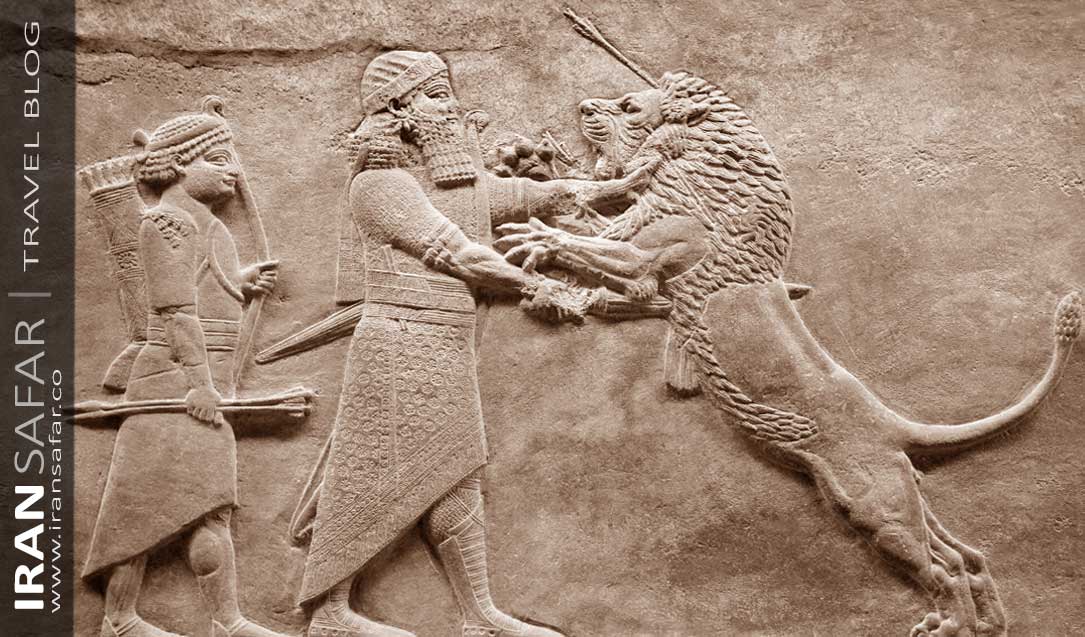 Ashur Banipal’s lion hunt
Ashur Banipal’s lion hunt
The Assyrian government, which gained power by defeating the claimants and occupying Mesopotamia, made the continuation of conquests the basis of its work. Therefore, from the 12th century BC. – which is the beginning of Assyrians gaining power -we see them constantly fighting with their neighbors, conquering territories, and looting prosperous cities. The inscriptions and bas-reliefs left by the Assyrians contain a lot of information about these wars and violation.
In the 9th century BC, Shalmansar III expanded the Assyrian territory to the Mediterranean coast, and in the 8th century BC, the kings of Assyria, Babylon, Elam, and the mountainous areas north of their territory in Asia Minor and Zagros, made it a field of conquest. Ashur Banipal, the famous king of Assyria, also conquered Egypt in the seventh century and increased the intensity of the attack on the surrounding lands of Assyria.
The prosperity and glory of the Assyrian government, which caused fear and panic in everyone, gradually ended. The revolt of Babylon under in 626 BC, in combination with an invasion by the Medes under Cyaxares in 615 – 614 BC, led to the Medo-Babylonian conquest of the Assyrian Empire. The wounded neighbors of Assyria joined hands with each other and decided to destroy it. It took place with the union of the Median state, which was established in Iran, and the Chaldean state, which was established in the south of Mesopotamia. Assur was sacked in 614 BC and Nineveh fell in 612 BC after a bloody war and Ashur-uballit II the king of Assyria was killed – marking the end of the ancient line of Assyrian kings and of Assyria as a state.
Read : Pasargadae – Amazing Facts, History, Site Map
5
NEO BABYLONIANS
The Neo-Babylonians, also known as the Chaldean Empire, were a dominant Mesopotamian civilization that rose to power during the late 7th and 6th centuries BCE. Their reign marked a significant period in history, characterized by military might, cultural advancements, and architectural wonders.
The roots of the Neo-Babylonians can be traced back to the ancient city of Babylon, which was one of the most prominent urban centers in Mesopotamia. The region was previously ruled by various empires, such as the Assyrians, who had conquered Babylon. However, a resurgence of Babylonian power in the 7th century BCE led to the establishment of the Neo-Babylonian Empire.
Under the leadership of the later King Nabopolassar, the Chaldeans rebelled against the Assyrians and successfully gained independence for Babylon. Nabopolassar’s son, Nebuchadnezzar II, ascended to the throne and further expanded the empire’s influence and territory. Nebuchadnezzar’s reign is often considered the golden era of the Neo-Babylonians, characterized by impressive accomplishments.
Nebuchadnezzar II was a remarkable ruler whose ambitious vision left an indelible mark on the empire. He undertook various construction projects, including the legendary Hanging Gardens of Babylon, one of the Seven Wonders of the Ancient World. Nebuchadnezzar also fortified the city, making Babylon an impregnable fortress.
The Neo-Babylonians were formidable warriors and strategic conquerors. Beyond their military might, they were avid patrons of art, literature, and science. They made significant advancements in astronomy and mathematics, and their cuneiform writing system facilitated the documentation of knowledge and culture.
Downfall of Neo Babylonian Empire
Despite their successes, the Neo-Babylonians faced internal strife and external pressures that contributed to their decline. After Nebuchadnezzar II’s death, the empire witnessed a series of weak rulers, leading to instability and vulnerability.
The conquest of Babylon by Cyrus the Great was a significant historical event that took place in 539 BCE. Cyrus the Great, the founder of the Achaemenid Empire, was a Persian king known for his military prowess and diplomatic skills. At the time of the conquest, Babylon was ruled by King Nabonidus. Cyrus, seeking to expand his empire and assert Persian dominance, set his sights on Babylon. The exact details of the conquest are recorded in the Cyrus Cylinder, an ancient clay cylinder with inscriptions describing the events from Cyrus’s perspective. According to the cylinder, Cyrus’s army entered Babylon without facing much resistance from the city’s residents. The Babylonian god Marduk was credited with favoring Cyrus and ensuring a peaceful transition of power.
Cyrus’s conquest of Babylon is considered a crucial event in world history. It marked the downfall of the Neo-Babylonian Empire and the rise of the Achaemenid Empire, which would become one of the most significant and influential empires in antiquity. Cyrus’s reputation as a benevolent ruler and his policies of religious and cultural tolerance contributed to his legacy as a model for just and compassionate leadership.
Also Read: Persepolis Ultimate Guide
Mesopotamia Civilization Timeline
7000-5500 BCE Early Neolithic
4700 BCE Hassunah period: earliest pottery making culture
4500 BCE The City of Uruk founded.
4400 BCE Halaf period: pottery culture with knowledge of metal
4000 BCE First settlement of Ur.
3900 BCE Ubaid period in Sumer: first well-known culture from southern Mesopotamia; the Ubaids – first evidence of temple and other sophisicated architecture
3600 BCE Invention of writing in Sumer at Uruk.
3400 BCE Priests become the rulers of Mesopotamian cities.
2900 BCE Start of the Early Dynastic Period in Sumer.
2750 BCE First Sumerian dynasty of Ur
2570 BCE First Dynasty of Lagash under King Eannutum – first empire in Mesopotamia.
2340-2125 BCE Akkadian rule in Mesopotamia
2334 BCE – 2279 BCE Sargon of Akkad reigns over Mesopotamia
2330 BCE Sargon of Akkad sacks the city of Ur.
2047-1750 BCE Third Sumerian dynasty of Ur – the Sumerian Renaissance.
1795 BCE – 1750 BCE Reign of Hammurabi, king of Babylon.
1792 BCE King Hammurabi builds walls of Babylon.
1500 BCE Rise of the kingdom of Mitanni.
1220-612 BCE Assyrian period
1220 BCE Babylon is under Assyrian control.
612-539 BCE Neo-Babylonian Period
539 BCE Conquest of Babylon by Cyrus the Great of Persia, Return of the Jewish community.
539-331 BCE Persian Era
Ancient Mesopotamia – FAQs
Q: What is the Ancient Mesopotamia known for?
Ancient Mesopotamia civilization holds immense significance as the cradle of civilization. It laid the foundations for urban life, agriculture, writing systems, and legal codes that shaped the course of human history.
Q: What were the Ancient civilizations in Mesopotamia?
Sumerians, Akkadians, Babylonians, Assyrians, Chaldeans
Q: What is ancient Mesopotamia called today?
The region is now home to modern-day Iraq, Iran, Kuwait, Turkey and Syria.
Q: What were Ziggurats in the ancient Mesopotamia?
Ziggurats were yramid-shaped temples showcasing remarkable engineering and architectural prowess.
Q: How did the Mesopotamians contribute to astronomy?
The Mesopotamians made significant contributions to astronomy by recording celestial events, tracking the movements of planets and stars, and developing the earliest known star catalogs.
Q: What were the main accomplishments of Hammurabi’s reign?
Hammurabi’s reign was marked by the establishment of the “Code of Hammurabi,” a comprehensive legal code that influenced future legal systems and emphasized principles of justice and fairness.
Q: Were women allowed to hold positions of power in Mesopotamian society?
While Ancient Mesopotamia was primarily a patriarchal society, some women held positions of power and influence. Notable examples include Enheduanna, a high priestess and poetess.

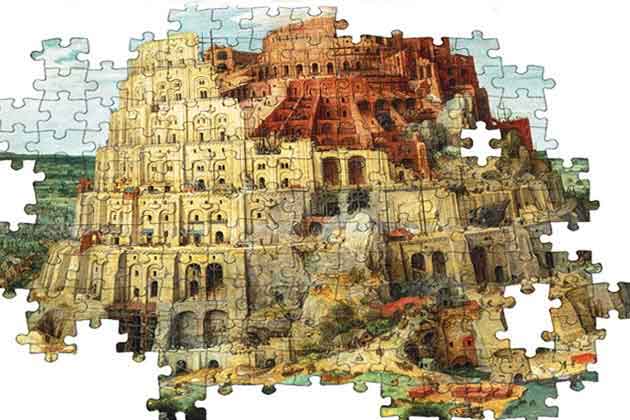
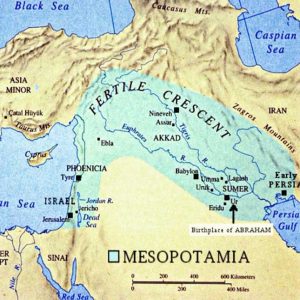

So far It is the best informative article I have read about history of meopotamia and the old civilizations.